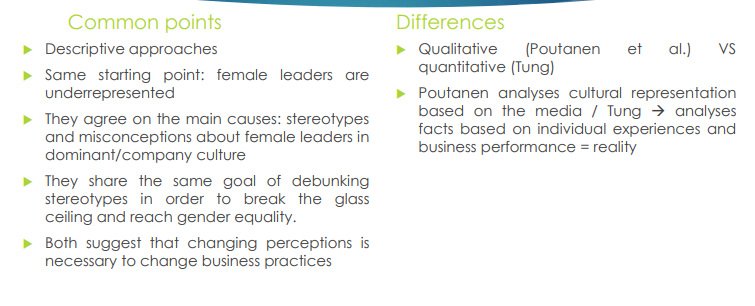“Construction of the female global top manager in The Economist” - Seppo Poutanen, et al.
1/9
There's no tags or description
Looks like no tags are added yet.
Name | Mastery | Learn | Test | Matching | Spaced |
|---|
No study sessions yet.
10 Terms
Who are the authors of the text? What are they specialists of ?
This article is the result of the collective work of three Finnish academics from the University of Turku: Seppo Poutanen, Anne Kovalainen and Jatta Jännäri. The first two are sociologists specialised in gender studies, while the latter is a specialist of management, and the issues related to gender.
What is the source of the text? Briefly describe its characteristics (type of publication, how often is it published, subjects, etc.).
The article was published in the International Journal of Media & Cultural Politics, which is a peer-reviewed interdisciplinary publication focusing on research in communication. It is published three times a year (triannual). It is destined to scholars as well as professionals of the field.
What is the date of publication? What are the relevant elements that can be found in the text about the context?
The article was published in 2016, therefore 12 years after that of Tung.
Since both articles take a similar indicator of the proportion of female CEOs at the head of the largest 500 American companies to assess the extent of the glass ceiling, it is possible to notice a slight increase from 2.4% in 2006 (Tung, p.244) to 4% (Poutanen et al., p.195).
What is the title of the text? What can you guess from it about the authors’ thesis?
This article is entitled “Construction of the female global top manager in The Economist”, which implies that the authors believe the media play a significant part in shaping the culture and the environment determining who should hold leadership positions, both at company and societal levels. They argue that the way female leaders are represented in The Economist reflects the stereotypes prevalent in the dominant culture.
What is the authors’ point of view? Do they seem to be in agreement with other specialists?
The authors stress the key role played by the media in constructing and spreading rigid gender roles and stereotypes. Their study is part of a wider effort to analyse how women are represented in the media and how it affects the perception of their abilities, their wider role in society, and therefore in companies’ organisational structures.
They point out the gap in scientific literature on the way specialised financial media contribute to gender inequality in leadership positions (p. 198).
What type of methodology is used in the article?
Their corpus is composed of articles published during an eight-year period (2006-2013) which were either centred on women in managerial positions or focused on their active roles, which reduced the number of articles studied to a total of 23 (p. 199).
Then, they used a method called critical discourse analysis to analyse the content of the articles and resorted to a form of thematic classification. Therefore, their approach is qualitative since it analyses texts (non-numerical data).
What are their main arguments? Use the connectors to identify the logic in their demonstration.
They demonstrate that female managers are depicted in the same stereotypical way as women in general, with a strong emphasis on their looks and family ties as daughters, wives and mothers.
Female managers described as competent are often presented as exceptional individuals, and portrayed as breaking away with traditional feminine traits.
Female managers are often questioned because of the implicit assumption of that the norm for women is to be in a subordinate position.
They conclude that the way top female managers are represented in The Economist do not threaten corporate and capitalist norms and values, since gender inequality is constructed as acceptable
What is the goal of the article? What are the authors trying to achieve?
The goal of the article is mainly descriptive. The three Finish researchers are trying to show how gender roles are represented in media specialised in covering business-related news to conclude that these stereotypical representations entrench and perpetuate gender inequality at the top of companies’ organisational structures.
Common points / differences

key question : How do both of these articles seek to debunk sexist stereotypes and misconceptions about female leaders in order to change cultural representations and business practices?
Deconstructing the systematic association between women and their families
Poutanen => traditional feminine role as the main carers in the family
Tung => imbalance between female and male expatriates having children + misconception that female managers will be unwilling to go on an international assignment
Challenging the idea that competence is a masculine trait
Poutanen => characteristics of managers associated with masculinity, focusing on their looks rather
than competence
Tung => female expatriates are equally as successful as men and feminine traits could be particularly suited for international assignments
Denouncing the corporate gender gap and the specific structural obstacles faced by female leaders within their companies
Poutanen => female leaders’ narratives connected to problems, portrayal as exceptional beings
Tung => link between foreign assignments as a prerequisite for leadership positions, suggestions to change HR policies